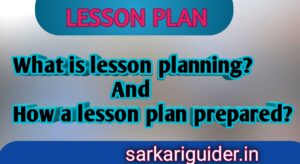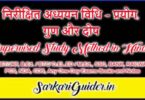lesson plan: Meaning/ Definition, & How to prepared

lesson plan
Meaning and Definition of Lesson Plan
Lesson plan is that small unit or units of subject matter which a teacher teaches in a definite period. A plan is more like a map which helps a teacher to navigate his/her way in classroom teaching. The pre- planning of essential activities that are required in the class teaching is known as a lesson plan.
According to Binning and Binning, “Daily lesson planning involves defining the objectives, selecting and arranging subject-matter and determining the method or procedure.”
According to Bossing, “Lesson plan is the title given to the statement of the achievements to be realised and the specific means by which these are attained as a result of activities engaged during the period.”
According to Dr. A.K.M. Parekh, “in the absence of a plan, written or unwritten, there would hardly occur any significant learning in the classroom”.
How a lesson plan is prepared?
1) Serial Number: The serial number on the lesson-plan facilitates him and his supervision to know the number of lessons taught and untaught.
2) Date: The pupil-teacher should write the date. This will keep the record of teaching the lessons on different dates.
3) Class: The lesson-plan must bear the class for which the pupil-teacher has prepared it.
4) Subject: The pupil-teacher should mention the subject on the lesson-plan because sometimes, the same lesson can be taught in the subjects like languages, history and geography, etc.
5) Time and Period: The pupil-teachers should also be cautious about the time and the period while preparing a lesson-plan.
6) Name of School: Sometimes, pupil-teachers go to many schools for teaching. Therefore, they must write the name of the school where they delivered their practice lessons.
7) Topic: In each textbook, the subject matter is divided into different chapters for convenience. The pupil- teachers should determine the topics for each day by dividing each chapter of the textbook into smaller sections considering the mental level of the class and representation of the thoughts as the basis. For example, for teaching history to ninth class, the chapter on ‘Akbar can be divided into many topics such as Reforms by, Administration of Akbar, etc.
8) General Aims or Objectives: The teaching of each lesson has two types of objectives. The general objectives can be achieved when the teaching of the subject is completed, but the specific objectives can be achieved when the lesson is being taught. the general aims are definite aims but the specific aims go on changing from lesson to lesson.
9) Specific Aims or Objectives: The specific objectives are concerned with the immediate lesson. It has been made clear that if a subject has general aims on one side, it has specific aims too on the other side. Hence, the pupil-teacher should write the specific aim of the lesson. For example, if in a lesson of History, the knowledge about Akbar’s administration is to be given, the pupil-teacher should write the specific aims as ‘The Administration of Akbar’.
10) Material Aid: Under this point, the pupil-teacher should mention in short that material aid with the help of which the pupils are to learn the lesson. those past
11) Previous Knowledge: It experiences of the pupils on the basis of which the teacher wants to develop the main lesson. Some people derive the meaning of previous knowledge from the studied matter. But in reality, it includes all those information and experiences which the pupils acquire in or outside the class with the help of their parents, neighbours and friends, directly or indirectly. The pupil-teacher should write such previous knowledge after selecting it with which the new knowledge can easily be linked.
12) Introduction: It means preparation. Hence, before starting the main lesson, the pupil-teacher should prepare the pupils to acquire new knowledge. The questions asked by the teacher from the pupils should be three or four in number and these should be in a sequence. This will enable the teachers to relate the previous and new knowledge and the statement of the objective will be easy.
13) Statement of Aim: As the introduction is over, the teacher should state the objective very clearly. Also, the topic should be written on the black-board.
14) Presentation: In this, the teacher should decide by accepting the principle of selecting and division, the amount of knowledge which he/she has to provide the pupils and which he/she is to receive from the pupils. Then he/she should divide the knowledge into two or three units after organising the subject matter in a natural and logical sequence. Some lessons can be taught in a single unit.
15) Comprehensive Questions: These questions are those questions with the help of which the teacher comes to know whether the pupils gained the understanding of the taught lesson or not. Hence, the teacher should mention some comprehensive questions at the end of each unit. The answers to such questions will indicate the limit of acquisition of new knowledge in the pupils.
16) Black-Board Summary: On the basis of comprehensive questions, the black-board summary is prepared. Therefore, the pupil-teachers should not write black- board summary at their own, but they should write the short form of the answers to the questions asked at the end of each unit. These should be clear and in meaningful sentences and the sequence should be such that those sentences present a complete thought.
17) Recapitulation: After presenting each unit, the teacher should mention some recapitulatory questions.
18) Home Work: After the recapitulation of the lesson, the teachers should assign the homework to the pupils
Important Links
- John Keats Biography
- Percy Bysshe Shelley Biography
- William Wordsworth as a Romantic Poet
- William Wordsworth as a poet of Nature
- William Wordsworth Biography
- William Collins Biography
- John Dryden Biography
- Alexander Pope Biography
- Metaphysical Poetry: Definition, Characteristics and John Donne as a Metaphysical Poet
- John Donne as a Metaphysical Poet
- Shakespeare’s Sonnet 116: (explained in hindi)
- What is poetry? What are its main characteristics?
- Debate- Meaning, Advantage & Limitations of Debate
- Sarojini Naidu (1879-1949) Biography, Quotes, & Poem Indian Weavers
- Charles Mackay: Poems Sympathy, summary & Quotes – Biography
- William Shakespeare – Quotes, Plays & Wife – Biography
- Ralph Waldo Emerson – Poems, Quotes & Books- Biography
- What is a lyric and what are its main forms?






